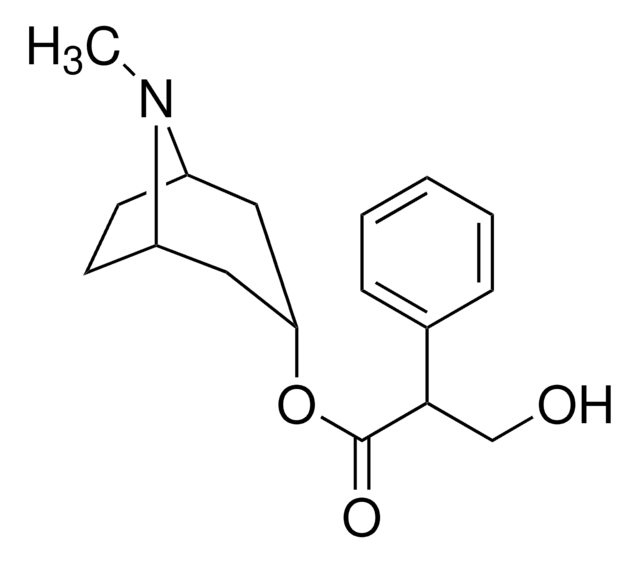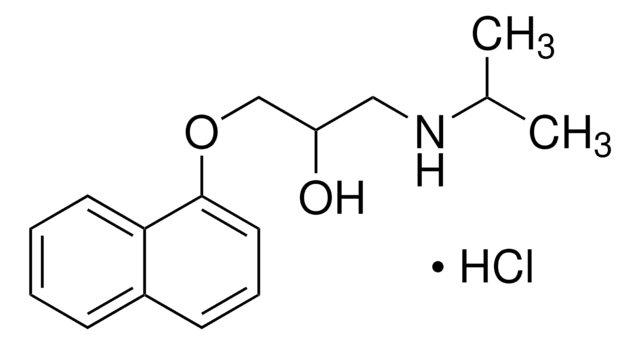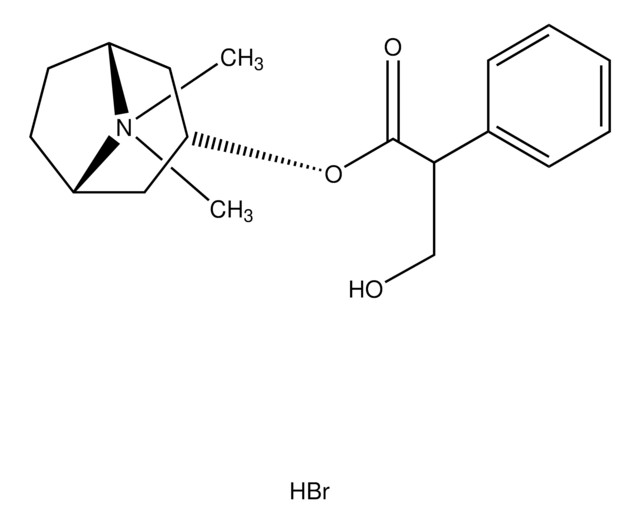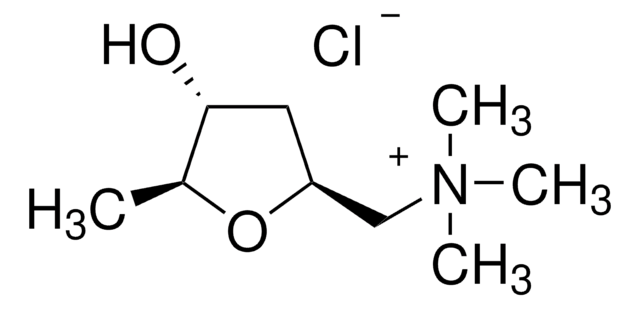Wichtige Dokumente
A0257
Atropin -sulfat (Salz) Monohydrat
≥97% (TLC), crystalline, cholinergic receptor antagonist
Synonym(e):
α-(Hydroxymethyl)-phenylessigsäure-8-methyl-8-azabicyclo[3.2.1]oct-3-ylester, (±)-Tropintropat
About This Item
Empfohlene Produkte
Produktbezeichnung
Atropin -sulfat (Salz) Monohydrat, ≥97% (TLC), crystalline
Assay
≥97% (TLC)
Form
crystalline
Farbe
white
mp (Schmelzpunkt)
189-192 °C (A) (lit.)
Löslichkeit
H2O: 2.5 g/mL (stable for several days at 4 °C.)
ethanol: 200 mg/mL (stable for several days at 4 °C.)
glycerol: 400 mg/mL (stable for several days at 4 °C.)
SMILES String
O.OS(O)(=O)=O.CN1[C@H]2CC[C@@H]1C[C@@H](C2)OC(=O)C(CO)c3ccccc3.CN4[C@H]5CC[C@@H]4C[C@@H](C5)OC(=O)C(CO)c6ccccc6
InChI
1S/2C17H23NO3.H2O4S.H2O/c2*1-18-13-7-8-14(18)10-15(9-13)21-17(20)16(11-19)12-5-3-2-4-6-12;1-5(2,3)4;/h2*2-6,13-16,19H,7-11H2,1H3;(H2,1,2,3,4);1H2/t2*13-,14+,15+,16?;;
InChIKey
JPKKQJKQTPNWTR-CHYDPLAESA-N
Angaben zum Gen
human ... CHRM1(1128) , CHRM2(1129) , CHRM3(1131) , CHRM4(1132) , CHRM5(1133)
Suchen Sie nach ähnlichen Produkten? Aufrufen Leitfaden zum Produktvergleich
Allgemeine Beschreibung
Anwendung
- to assay specific binding of high-affinity 3-quinuclidinyl benzilate-3H ([3H]QNB) to the muscarinic acetylcholine receptor (mAChR)
- to block the recovery phase of the aldicarb (Ald) response
- as an analyte for liquid chromatography with tandem mass spectrometry (LC-MS/MS)
- as a mAChR antagonist to block acetylcholine receptor
Biochem./physiol. Wirkung
Anwendung
Signalwort
Danger
H-Sätze
Gefahreneinstufungen
Acute Tox. 2 Inhalation - Acute Tox. 2 Oral
Lagerklassenschlüssel
6.1A - Combustible acute toxic Cat. 1 and 2 / very toxic hazardous materials
WGK
WGK 3
Persönliche Schutzausrüstung
Eyeshields, Faceshields, Gloves, type P3 (EN 143) respirator cartridges
Hier finden Sie alle aktuellen Versionen:
Besitzen Sie dieses Produkt bereits?
In der Dokumentenbibliothek finden Sie die Dokumentation zu den Produkten, die Sie kürzlich erworben haben.
Kunden haben sich ebenfalls angesehen
Unser Team von Wissenschaftlern verfügt über Erfahrung in allen Forschungsbereichen einschließlich Life Science, Materialwissenschaften, chemischer Synthese, Chromatographie, Analytik und vielen mehr..
Setzen Sie sich mit dem technischen Dienst in Verbindung.









